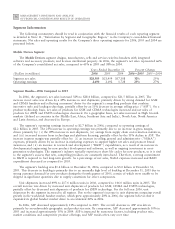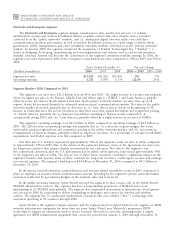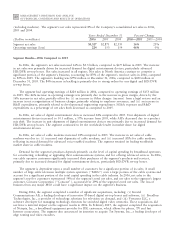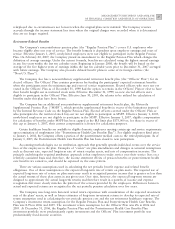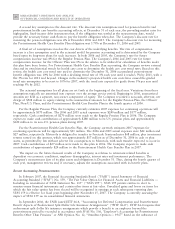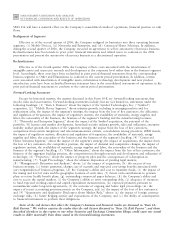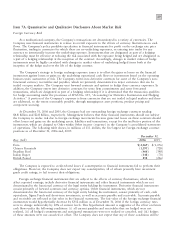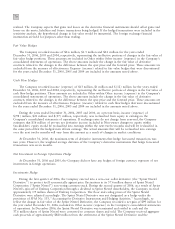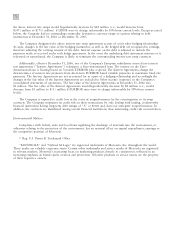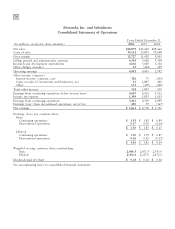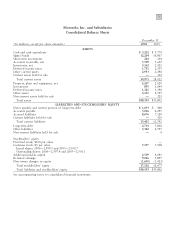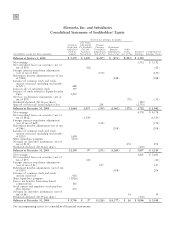Motorola 2006 Annual Report Download - page 74
Download and view the complete annual report
Please find page 74 of the 2006 Motorola annual report below. You can navigate through the pages in the report by either clicking on the pages listed below, or by using the keyword search tool below to find specific information within the annual report.
66 MANAGEMENT'S DISCUSSION AND ANALYSIS
OF FINANCIAL CONDITION AND RESULTS OF OPERATIONS
A second key assumption is the discount rate. The discount rate assumptions used for pension benefits and
postretirement health care benefits accounting reflects, at December 31 of each year, the prevailing market rates for
high-quality, fixed-income debt instruments that, if the obligation was settled at the measurement date, would
provide the necessary future cash flows to pay the benefit obligation when due. The Company's discount rate for
measuring the pension obligations was 6% at December 2006 and 2005. The Company's discount rate for measuring
the Postretirement Health Care Benefits Plan obligation was 5.75% at December 31, 2006 and 2005.
A final set of assumptions involves the cost drivers of the underlying benefits. The rate of compensation
increase is a key assumption used in the actuarial model for pension accounting and is determined by the Company
based upon its long-term plans for such increases. In both 2006 and 2005, the Company's rate for future
compensation increase was 4% for the Regular Pension Plan. The Company's 2006 and 2005 rate for future
compensation increase for the Officers' Plan was 0% as the salaries to be utilized for calculation of benefits under
this plan have been frozen. For Postretirement Health Care Benefits Plan accounting, the Company reviews external
data and its own historical trends for health care costs to determine the health care cost trend rates. Based on this
review, the health care cost trend rate used to determine the December 31, 2006 accumulated postretirement
benefit obligation was 10% for 2006 with a declining trend rate of 1% each year until it reaches 5% by 2011, with a
flat 5% rate for 2011 and beyond. Changes in the industry's projected health care costs have caused the graded
trend rate assumption to be reset to 10% for 2007, with the trend rate expected to grade down 1% per year until
reaching 5% by 2012.
The actuarial assumptions for all plans are set forth at the beginning of the fiscal year. Variations from these
assumptions typically are amortized into expense over the average service period. Beginning in 2006, unamortized
amounts are held as a separate, non-owner component of equity. The Company recorded a non-cash, after-tax, net
charge of $308 million to equity relating to the unamortized amounts for the Regular Pension Plan, the Officers'
Plan, Non-U.S. Plans, and the Postretirement Health Care Benefits Plan in the fourth quarter of 2006.
For the Regular Pension Plan, the Company currently estimates 2007 expenses for continuing operations will
be approximately $170 million. The 2006 and 2005 actual expenses were $240 million and $177 million,
respectively. Cash contributions of $270 million were made to the Regular Pension Plan in 2006. The Company
expects to make cash contributions of approximately $280 million to its U.S. pension plans and approximately
$120 million to its non-U.S. pension plans during 2007.
For the Postretirement Health Care Benefits Plan, the Company currently estimates 2007 expenses for
continuing operations will be approximately $21 million. The 2006 and 2005 actual expenses were $22 million and
$27 million, respectively. Motorola is obligated to transfer to Freescale Semiconductor $68 million, plus investment
returns earned on this amount, which was approximately $17 million as of December 31, 2006 in cash or plan
assets, as permitted by law without adverse tax consequences to Motorola, with such transfer expected to occur in
2007. Cash contributions of $27 million were made to this plan in 2006. The Company expects to make cash
contributions of approximately $24 million to the Postretirement Health Care Benefits Plan in 2007.
The impact on the future financial results of the Company in relation to retirement-related benefits is
dependent on economic conditions, employee demographics, interest rates and investment performance. The
Company's measurement date of its plan assets and obligations is December 31. Thus, during the fourth quarter of
each year, management reviews and, if necessary, adjusts the assumptions associated with its benefit plans.
Recent Accounting Pronouncements
In February 2007, the Financial Accounting Standards Board (""FASB'') issued Statement of Financial
Accounting Standard (""SFAS'') No. 159, ""The Fair Value Option for Financial Assets and Financial Liabilities Ì
Including an amendment of FASB Statement No. 115'' (""SFAS 159''). SFAS 159 permits entities to elect to
measure many financial instruments and certain other items at fair value. Unrealized gains and losses on items for
which the fair value option has been elected will be recognized in earnings at each subsequent reporting date.
SFAS 159 is effective for fiscal years beginning after November 15, 2007. The Company is currently assessing the
impact of SFAS 159 on its consolidated financial statements.
In September 2006, the FASB issued EITF 06-4, ""Accounting for Deferred Compensation and Postretirement
Benefit Aspects of Endorsement Split-Dollar Life Insurance Arrangements'' (""EITF 06-4''). EITF 06-4 requires that
endorsement split dollar life insurance arrangements which provide a benefit to an employee beyond the
postretirement period be recorded in accordance with SFAS No. 106, ""Employer's Accounting for Postretirement
Benefits Other Than Pensions'' or APB Opinion No. 12, ""Omnibus Opinion Ì 1967'' based on the substance of


